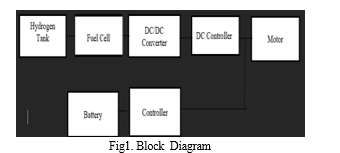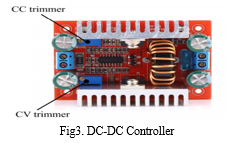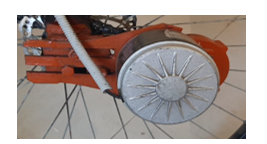Ijraset Journal For Research in Applied Science and Engineering Technology
- Home / Ijraset
- On This Page
- Abstract
- Introduction
- Conclusion
- References
- Copyright
Hydrogen-Powered Bicycle for Sustainable Mobility
Authors: Dr. Sanjay L. Kurkute, Saurabh R. Deshmukh, Rajashri N. Gunjal, Tanuja R. Deshmukh
DOI Link: https://doi.org/10.22214/ijraset.2024.60633
Certificate: View Certificate
Abstract
In the pursuit of sustainable transportation solutions, the integration of hydrogen fuel cells presents at the bicycles. This paper explores the high-level design considerations for a hydrogen-powered bicycle, focusing on key components such as the fuel cell system, hydrogen storage, powertrain, and overall vehicle architecture. The fuel cell system is a critical component, converting hydrogen gas into electricity to power an electric motor. The hydrogen storage system must be lightweight, compact, and safe, utilizing advanced materials and technologies to store hydrogen at high pressures. The powertrain of the hydrogen-powered bicycle involves the integration of the electric motor with the bicycle\'s drivetrain, ensuring efficient power delivered to the wheels. The overall vehicle architecture considers the integration of these components into a functional, user-friendly, and aesthetically pleasing design. Additionally, the paper discusses the environmental impact of hydrogen-powered bicycles, comparing them to traditional bicycles and other forms of transportation. The potential benefits of hydrogen-powered bicycles include zero-emission operation, long-range capabilities, and rapid refuelling times. Overall, the development of hydrogen-powered bicycles has the potential to revolutionize urban mobility, offering a clean, efficient, and sustainable alternative to traditional transportation methods.
Introduction
I. INTRODUCTION
Develop a hydrogen fuel cell-powered bicycle that offers an environmentally friendly and efficient alternative to traditional gasoline or electric bicycles. The bicycle should be capable of traveling are as on able distance, provide a Smooth and consistent power output, and be safe and user-friendly. Create a sustainable and eco-friendly mode of transportation that contributes to reducing carbon emission sand promoting a cleaner environment. It is serve as a stepping stone for the development of larger-scale hydrogen fuel cell vehicles in the future. Compared to conventional vehicles, hybrid electric vehicles (HEVs) are more fuel efficient due to the optimization of the engine operation and recovery of kinetic energy during braking. With the plug-in option (PHEV), the vehicle can be operated on electric-only modes for a driving range of up to 30–60 km. The PHEVs are charged overnight
from the electric power grid where energy can be generated from renewable sources such as wind and solar energy and from nuclear energy. Fuel cell vehicles (FCV) use hydrogen as fuel to produce electricity, therefore they are basically emission free. When connected to electric power grid (V2G), the FCV can provide electricity for emergency power backup during a power outage. Due to hydrogen production, storage, and the technical limitations of fuel cells at the present time, FCVs are not available to the general public yet. HEVs are likely to dominate the advanced propulsion in coming years. Hybrid technologies can be used for almost all kinds of fuels and engines. Therefore, it is not a transition technology. The road map of hybrid technologies. In HEVs and FCVs, there are more electrical com-ponents used, such as electric machines, power electronic converters, batteries, ultracapacitors, sensors, and micro-controllers. In addition to these electrification components or subsystems, conventional internal combustion engines, and mechanical and hydraulic systems may still be present. The challenge presented by these advanced propulsion systems include advanced powertrain components design, such as power electronic converters, electric machines and energy storage; power management; modelling and simulation of the powertrain system; hybrid control theory and optimization of vehicle control.
II. HARDWARE DESIGN OF THE SYSTEM
The original e-bike is powered by a 250W 24V brushless electric motor (EM) mounted on the rear wheel, and it has a battery pack with capacity of 10Ah (750 Watt). The new Hy Bike keeps the same EM and driver, but its hybrid power unit is composed instead by a PEM fuel cell (FC) and a smaller battery pack. The hydrogen is solid-state stored in a MH tank that operates also as thermal management system for the battery pack. The FC is connected to the battery pack via a DC/DC step-up converter, that stabilizes the output voltage of the FC and controls its power output. In this way, the power produced by the FC stack can be either used by the EM or to charge the battery pack. A schematic representation of the fuel cell/battery hybrid power unit architecture is reported.

The battery in the new power unit provides the power required by the EM during transient operations, while the FC operates basically as a range extender, providing the
required average power and avoiding the battery pack State of Charge (SoC) to drop below a minimum threshold. In particular, the FC charges the battery whenever the power requested by the EM is sufficiently
low, while the battery is discharged when the power demand is higher than the power output of the FC. Anyhow, the charging current of the battery pack can
never be higher than its allowed maximum (that for a lithium-ion battery is usually much lower than the discharge current one).
A. Fuel Cell
There are various types of FC systems. However, the principle of their function is similar. For a fuel cell system, three pillars are required: an anode, a cathode, and an electrolyte. FCs are categorized by the type of electrolyte material used. An FC can be composed of hundreds of individual cells, but each has the three same fundamental components. The electrolyte is located between the cathode and the anode. Depicts a schematic of a polymer electrolyte FC (PEMFC) operation diagram. This FC type is also known as a proton exchange membrane FC. The PEMFC is what is most commonly used in mobile power applications, such as vehicles. While the electrolyte material used varies depending on the type of FC, the general function of the FC is as follows fuel (pure hydrogen) is fed into the anode compartment of the fuel cell while air or pure oxygen is fed into the cathode side of the FC. On the anode side of the cell, electrons are separated as the gas tries to make its way through the electrolyte membrane. The membrane acts as a filter to separate the electrons and the hydrogen ions while only allowing the hydrogen ions to pass through. In the cathode compartment, the hydrogen ions that passed through the membrane combine with the oxygen atoms from the air supply to produce H2O as a by-product; heat is also produced as a by-product. Unlike internal combustion engines, where the fuel is mixed with air and fuel, there is separation of the fuel and the oxidant with no combustion of the fuel in an FC. Therefore, FCs do not produce the harmful emissions that internal combustion engines produce electric vehicles were a strong contender in the early 20th century to become a mainstream transportation method, the ICE vehicle eventually won out due to the short range and the high cost of electric vehicles.

B. DC Controller
Increasing concerns regarding climate change have encouraged the adoption of vehicles. Vehicles offer low carbon emissions, a minimum dependency on non-renewable resources, and promote innovation in the automotive sector. Hence, the need to learn more about EVs is the need of the hour. By the definition of electric vehicle controller (EVC), it is a combination of a powertrain control unit (PCU) and driver control unit (DCU) used between various electrical and mechanical components of an electric vehicle. The functioning of the EVC is similar to that of a carburetor in a gasoline-powered vehicle. The electric vehicle controller controls various tasks, including: Power Distribution to an Electric Vehicle: Based on the system requirements, it distributes the power to different sectors throughout the electric vehicle. Torque Production and the Speed of the Electric Motor. The EV controller translates the driver’s input into the amount of current to be sent to the electric motor. It allows the driver to accelerate and decelerate the vehicle. Charging System of the Electric Vehicle: The EV controller manages the vehicle’s charging system. It streamlines the current flow and maintains the voltage distribution for better charging and working. Managing Battery Performance and Health: It acts as a battery manager. The electric vehicle controller continuously monitors the battery of the vehicle for its temperature, current flow, and voltage. It ensures that the vehicle’s battery is working within the permissive parameters. Controls Necessary Signals and Communication Mechanisms: The controller plays the role of a bridge, transmitting signals between the driver and the vehicle’s intricate system and back again. For example, it relays crucial data such as the charge level, battery performance, the vehicle’s motion, and other essential information.
C. DC-DC Converter
The power of the FC is controlled by a DC/DC converter placed between the FC and the battery pack. Since a programmable DC/DC converter that is suitable for the specific application was not find available on the market, a commercial DC/DC converter was instead used after ad-hoc modified. The employed DC/DC converter, before the trimmer substitution. The used converter is able to work both in CV mode (constant output voltage) and CC mode (constant output current): when the current is lower than the reference value (set through the CC trimmer), the DC/DC converter provides a constant output voltage (set through the CV trimmer); otherwise, as the current tends to exceed the reference value, the output voltage is lowered in order to maintain the output current equal to the reference value. Substituting the CC trimmer with a digital potentiometer, which is a variable resistance controlled by an electronic control unit, it is possible to control in real-time the DC/DC output current and so the power supplied by the FC. The CV trimmer was set to an output voltage of 24 V, so that the battery overcharging would be avoided in any case (the maximum operating voltage for a 12V Fuel Cell is 24 V). The power unit of the Hydrogen Bike must be contained in a small space and arranged in such a way as not to negatively affect the comfort and drivability of the vehicle. Therefore, an extremely compact design was realized for the casing containing the power unit, which was finally positioned at the rear of the Hydrogen Bike. The generic ESP8266 module is a miniature microcontroller board which has RAM, ROM, clock, communication protocols and I/O pins just like any other microcontrollers and it need to be programmed to make it functional.

D. Battery
A lithium-ion or Li-ion battery is a type of rechargeable battery which uses the reversible intercalation of Li+ ions into electronically conducting solids to store energy. In comparison with other rechargeable batteries, Li-ion batteries are characterized by a higher specific energy, higher energy density, higher energy efficiency, longer cycle life and longer calendar life. The invention and commercialization of Li-ion batteries is considered as having one of the largest societal impacts in human history among all technologies as was recognized. More specifically, Li-ion batteries enabled portable consumer electronics, laptop computers, cellular phones and electric cars, or what has been called e-mobility revolution. It also sees significant use for grid-scale energy storage, as well as military and aerospace.

E. Motor
Brushed DC motors, featuring simple design and easy control, are widely used to open and close disk trays. In cars, they are often used for retracting, extending, and positioning electrically-powered side windows. The low cost of these motors makes them suitable for many uses. One drawback, however, is that brushes and commutators tend to wear relatively quickly as a result of their continued contact, requiring frequent replacement and periodic maintenance. A stepper motor is driven by pulses; it rotates through a specific angle (step) with each pulse. Because the rotation is precisely controlled by the number of pulses received, these motors are widely used to implement positional adjustments. They are often used, for example, to control paper feed in fax machines and printers—since these devices feed paper in fixed steps, which are easily correlated with pulse count. Pausing can also be easily controlled, as motor rotation stops instantly when the pulse signal is interrupted. With synchronous motors, rotation is synchronous with the frequency of the supply current. These motors are often used to drive the rotating trays in microwave ovens; reduction gears in the motor unit can be used to obtain the appropriate rotational speeds to heat food. With induction motors, too, the rotation speed varies with frequency; but the movement is not synchronous. In the past, these motors were often used in electric fans and washing machines.

III. ALTERNATE FUEL TECHNOLOGY
A. Electric Bicycles (E-Bikes)
Compared to traditional e-bikes, hydrogen-powered bicycles offer potentially longer range and faster refuelling times. However, they are likely to be more expensive due to the cost of hydrogen fuel cells and storage tanks.
B. Battery Electric Vehicles (BEVs)
BEVs have larger batteries than hydrogen-powered bicycles, providing longer ranges on a single charge. However, hydrogen-powered bicycles can refuel much faster than BEVs can recharge, making them more convenient for longer trips.
C. Internal Combustion Engine (ICE) Bicycles
ICE bicycles rely on fossil fuels, producing emissions harmful to the environment. In contrast, hydrogen-powered bicycles produce zero emissions at the point of use, making them much more environmentally friendly.
D. Hybrid Bicycles
Hybrid bicycles combine human power with an electric motor, usually powered by a battery. While they offer some of the benefits of hydrogen-powered bicycles, they do not provide the same range or refuelling speed.
IV. CUSTOMER BENEFITS
- Longer Range: Hydrogen-powered bicycles typically have a longer range compared to electric bicycles, allowing riders to travel greater distances without recharging.
- Fast Refuelling: Refuelling a hydrogen-powered bicycle is quick and easy, similar to refuelling a traditional bicycle with gasoline, making it convenient for users.
- Energy Efficiency: Hydrogen fuel cells are more energy-efficient than internal combustion engines, converting a higher percentage of fuel into usable energy, which can result in cost savings for users.
- Reduced Maintenance: Hydrogen fuel cells have fewer moving parts compared to internal combustion engines, resulting in lower maintenance costs and increased reliability for users.
V. SYSTEM TEST
In order to verify the correct operation of the designed system, in experimental tests were carried out. These were performed by using a regenerative BTS, which uses the power profiles acquired during the design phase to emulate the actual vehicle operation. The employed BTS model, which has maximum power, voltage and current output equal to 250 W, 24 V and 10 A, respectively. Specifically, with the aim of investigating the power unit performances under the different modes of operation prescribed by the power sharing control algorithm, the two tests were carried out by imposing different initial conditions, in terms of battery SoC, for the Urban Cycle, the initial battery SoC has been set to 39%. The obtained fuel cell SoC profiles, during the two tests. It should be noted that the average FC efficiency is higher, in this case, the FC operates at constant power, with value close to the point of maximum efficiency. Considering that the MH storage tank has a hydrogen capacity of 50 g, the Hy Bike results to achieve a riding range of about 35 km in charge sustaining mode, while its all-electric range, is about 25 km, thus leading to an overall estimated range of 40 km. This value is significantly higher than that for the original hybrid-cycle, for which a riding range of roughly 40 km is estimated, considering the same test conditions and under the same assumption of fuel cell DoD.
Conclusion
A new hydrogen-powered bicycle has been presented in this study. The peculiarity of this vehicle lies in its on-board energy storage system: a hybrid system which is based on the thermal integration between a metal hydride tank and the battery pack. By this way, not only the storage energy density of the vehicle is enhanced, but also an optimal thermal management of the two components may be achieved. Specifically, the design of the power unit of the vehicle and of its hybrid energy storage system have been shown in this work. Thus, a prototype has been realized and bench-tested, in order to check design consistency and to evaluate its performances. The results are very promising: the riding range of the Hydrogen Bike is about three times higher the one of the original e-bike. This may open interesting prospects towards a more sustainable urban mobility, since the new Hydrogen Bike can potentially play a significant role in the light-vehicles panorama. Further investigations will be devoted to the assessment of the hybrid energy storage system, in terms of thermal management capabilities.
References
[1] Nassif and S. C. A. d. Almeida, Int. J.Hydrogen Energy 45, 21722 (2020) [2] H. Zhang, X. Li, X. Liu, and J. Yan, Appl.Energy 241, 483 (2019) [3] Fuel Cells Bull. 2018, 4 (2018) [4] G. Di Ilio, P. Di Giorgio, L. Tribioli, G. Bella, and E. Jannelli, Energy Convers. Manag. 243, 114423 [5] G. Di Ilio, P. Di Giorgio, L. Tribioli, V. Cigolotti, G. Bella, and E. Jannelli, SAE Tech.Pap. 2021-24-0109 [6] M. Minutillo, A. Forcina, N. Jannelli, and A. Lubrano Lavadera, Energy 153, 200 (2018) [7] J. L. Shang and B. G. Pollet, Int. J. Hydrogen Energy 35, 12709 (2010) [8] P. Di Trolio, P. Di Giorgio, M. Genovese, E. Frasci, and M. Minutillo, Appl. Energy 279, 115734 [9] Perna, M. Minutillo, S. Di Micco, V. Cigolotti, and A. Pianese, E3S Web Conf. 197, 5001 (2020) [10] C. Zamfirescu and I. Dincer, J. Power Sources 185, 459 (2008) [11] K. P. Brooks, S. J. Sprik, D. A. Tamburello, and M. J. Thornton, Int. J. Hydrogen Energy 45,24917 [12] Horizon Fuel Cell Technologies, H-200 Fuel Cell Stack User Manual (2021) [13] GWL Power, Li-Ion Cell LG MH1 Data Sheet (2021) [14] B. Tanç, H. T. Arat, Ç. Conker, E. Baltacio?lu, and K. Aydin, Int. J. Hydrogen Energy 45, 26344 [15] C. H. Chao and J. J. Shieh, Int. J. Hydrogen Energy 37, 13141 (2012) [16] L. Xu, M. Ouyang, J. Li, F. Yang, L. Lu, and J. Hua, Appl. Energy 103, 477 (2013)
Copyright
Copyright © 2024 Dr. Sanjay L. Kurkute, Saurabh R. Deshmukh, Rajashri N. Gunjal, Tanuja R. Deshmukh. This is an open access article distributed under the Creative Commons Attribution License, which permits unrestricted use, distribution, and reproduction in any medium, provided the original work is properly cited.

Download Paper
Paper Id : IJRASET60633
Publish Date : 2024-04-19
ISSN : 2321-9653
Publisher Name : IJRASET
DOI Link : Click Here
 Submit Paper Online
Submit Paper Online

